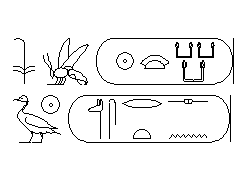
The fifth king of the 12th Dynasty. Although Senwosret III probably campaigned in both Palestine and Syria, he is best known for his campaigns in Nubia, where he completed the conquest started by his predecessors. During the Middle Kingdom he was already worshipped as a god in Nubia, and in the New Kingdom and later he was regarded as the lord of Nubia. The temple of Thutmosis III at Semna is dedicated to him and to a local deity.
Senwosret III initiated important administrative reforms which reduced the power of the provincial rulers and transferred it instead to a large bureaucratic organization. Most of the remains of buildings dating to his reign are found in Lower Egypt, for example some imposing statues at Karnak, important reliefs and statues from a large temple of Montu at Medamud, and a statue and numerous stelae from Abydos. A large cenotaph at Abydos is also attributed to him, even though this is only based on cartouches on statues in the associated valley temple. Very few traces have been found north of Abydos. The most impressive of Senwosret III's legacies is the royal sculpture. Deviating from earlier conventions, the king is depicted with an aged, worried face on which the burden of kingship is easy to read.
The most important description of the 'mysteries' celebrated around the tomb of Osiris at Abydos date to the reign of Senwosret III - on the stela of Ikhernofret, who was the king's treasurer. The so-called Kahun Papyri, which record hymns to Senwosret and documents relating to the Sed-festival that took place in year 7 of Senwosret's reign, play an important part in our understanding of Egyptian kingship.
The king's stone pyramid is located at Dahshour, surrounded by the tombs of the royal family. This site is famous for the jewellery that has been found there.